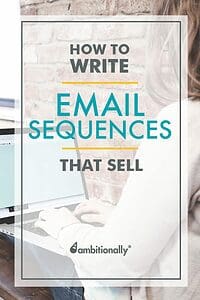I’ve got an admission to make: I’m often a list-building business owner’s worst nightmare.
I subscribe to a lot of newsletters…but as soon as the emails turn a sales pitch, I hit unsubscribe. My apologies if I’ve ever done this to you!
But here’s the thing: I get it. Online businesses only work if sales are happening.
Unfortunately, the sales pitch generally happens at a really awkward time in the email sequences. All too often, that sales push happens after receiving a couple of really bland emails that I didn’t bother to read past the first sentence or two. Sometimes, the call to action was very boldly made in the first email, well before I had time to read anything or establish some trust in the business owner.
When I unsubscribe from an email list, it’s because I’m convinced that it’s not worth my time or the business owner’s to stay subscribed, when I can clearly see that they only thing they want from me, is to be another number on their list of conversions.
The “just another sale” vibe can be hard to avoid. And for a long time, I thought it was an inevitable part of email marketing and newsletters.
Until, I dug in, and got to know my audience, and what they wanted.
That’s when I realized that writing email sequences that sell is an art and you can successfully sell what you’re offering without alienating your subscribers.
Is This Happening To You?
Whether you’ve got a huge list that’s stagnant and not converting, or you’ve got a bunch of people like me who just unsubscribe with no warning, it can be really frustrating.
List-building is hard work, and it’s tough to see your efforts go down the drain.
[Tweet “List-building is hard work … is your list paying off? #onlinemarketing #entrepreneur”]
The challenge is just a part of being an online business owner. At some point, you have to monetize what you put your time and effort into. Having hundreds (or thousands) of people on your email list isn’t really that impressive if no one actually buys anything from you. Although learning how to build a large email list from scratch is part of this process.
Compare the top course & membership platforms
We’ve done the research, so you can make the right decision for your business.
 Compare Your Options
Compare Your OptionsWriting Email Sequences is an Art – It’s Not Just About Good Grammar
The ability to write compelling email sequences that sell is more than just being able to write well. It goes much deeper than spelling words correctly (that’s what spellcheck is for, am I right?) and writing snappy headlines.
But all too often, that’s what an email newsletter boils down to.


While it’s actually pretty important to learn the particulars like “how to write a headline” or “the benefits of plain text versus styled newsletters”, there’s also a lot of value in stepping back to see how all the gears work together.
What Makes An Email Sequence Successful?
It’s not just about writing clickable headlines or making sure your links aren’t spammy.
It goes deeper.


To take your email marketing to the next level, you have to be committed to building an email sequence that’s fully automated and ready to convert, whether you plan on using it for people who just joined your list or are going to apply it to your next launch or promotion.
You don’t have to be a master copywriter to write your own emails, but a foundational knowledge of what goes where will definitely make a difference.
An 8 Step Email Sequence That Sells
Here’s my proven formula that will help you sell your products and services organically through your email sequences.
Each email sequence should be tailored to each individual product or offer, based on the lead magnet that made them raise their hand and say, yes, they want to hear from you.
This is the exact strategy we use to design successful email sequences in our business.
Email #1: Intro Email
In this email, you need to deliver on your promise and give them exactly what they signed up for. Your goal is to build trust, and set the tone for what they can expect now that they are part of your list.
Email #2: Pure Value
In this email, you want to give, give, give. It’s all about overdelivering and providing pure value chockfull of tips and advice.
Email #3: Overcome Objections
Use this email to address the objections you most often see from people who are considering purchasing the product or service you are offering. I highly recommend providing even more value by providing even more advice for free. If this subscriber never buys from you, they should still walk away with valuable insights and actionable steps.
Email #4: Announce Your Offer
Ask for the sale in this email. You may have hinted about this product or offer in a previous email, but this email is all about the product or offer you’re selling. You want to provide just enough detail about the product and service you’re selling to have them curious enough to click through and learn more.
Email #5: Social Proof
Use testimonials from current and past customers to build credibility for you and your product or service. Case studies are also a great sales tool and make great email content. Be sure to help the subscriber, aka your potential customer, understand why what you’re selling will work for them.
Email #6: Offer a Bonus
You’re getting close to the end of your email sequence, so it’s the perfect opportunity to offer a limited time bonus to anyone who buys before a given deadline. This helps build scarcity in your offer and increases the likelihood of making a sale.
Email #7: Stack Bonuses
This is the second to last email in this sequence so you want to make it a no-brainer for the reader to purchase at this point. It’s a great opportunity to get potential customers off the fence because they really feel like they are getting a great deal and a ton of value for the price they are paying.
Email #8: Last Call
Always include a last call email in your email sequences. In my experience, this is the email that converts the largest number of sales. Your subscribers won’t want to miss out on the limited time offers you’ve made available. Not everyone reads every email, so this is a great opportunity to catch subscribers who may have missed a previous email, as well as, announcing these bonus offers.
As you can see every email in this sequence has a different purpose and goal, so be conscious about the intention as you begin writing.
The Writing Process
Remember you are in control of this communication platform, and the biggest mistake I see entrepreneurs make is not being strategic and specific by designing different email sequences for each of their products or offerings.
Do your best to keep emails around 300 words or less when your goal is to get them to click through. If you’re sending them to a video or resource, these emails can be shorter.
Longer emails ranging in the 400-700 word range are ideal for delivering a lot of value – these tend to be your pure value, overcoming objections, and social proof emails.
Your goal is to create just enough curiosity for them to take action.
Here’s what my writing process looks like:
- Define the product or service you want to sell for this specific email sequence.
- Map out your email sequence thinking about the content of each email and how it leads to the desired outcome.
- Decide which bonuses you want to offer to complement your offer.
- Turn off distractions. Block your internet, silence your phone, and get to writing.
- Get it out there. It doesn’t have to be perfect, you can improve over time.
- Analyze the data, and optimize the sequence.
Use an email marketing system or CRM system to set up smart sequences so you can turn each email sequence on or off based on the actions your subscriber takes. When someone makes a purchase, you don’t want to continue emailing them, convincing them to buy something they already own.
Here are a few tips to keep in mind as you write so you can avoid the “just another sale” vibe we talked about at the beginning of this article.
Ask this question: “How do you want people to feel when they read this email?”
Write as if you’re talking to just one person. It helps keep the email from sounding and feeling like a marketing and sales pitch.
Train your subscribers to open your emails by setting their expectations in the first email they receive delivering their free gift.
Now it’s your turn. Get started writing your email sequences that sell for your online courses, membership site, and services.







